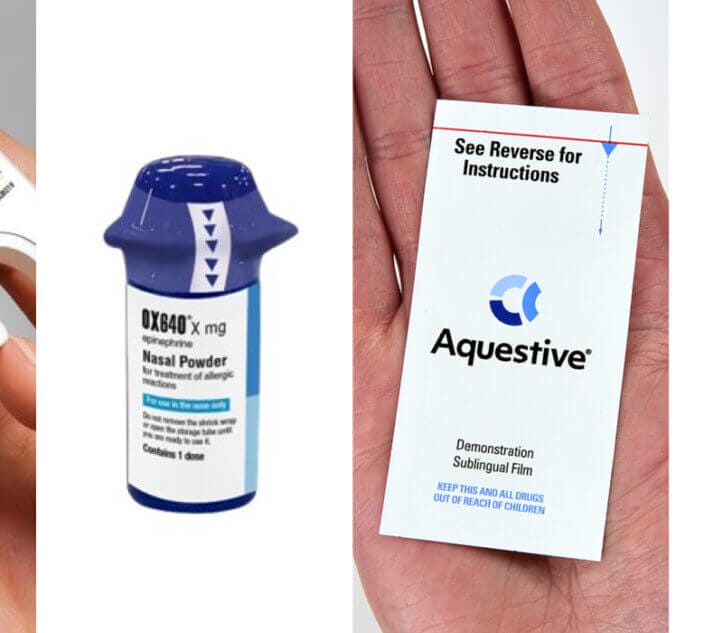
Concerns are rising over access to appropriate asthma medications after the discontinuation of Flovent brand corticosteroid inhalers. An authorized generic version is being introduced to replace the branded inhalers.
However, doctors and asthma advocates are expressing worries over the change. First, there are few similar alternatives to the popular Flovent corticosteroid inhaler. And second, there is concern about barriers to insurance coverage for the new generic version.
As well, there is the magnitude of the transition. Almost 27 million Americans live with asthma, and many regularly use asthma steroid inhalers.
As of January 1, 2024, GlaxoSmithKline stopped manufacturing the branded Flovent HFA aerosol inhaler and the Flovent Diskus inhalation powder. They contain fluticasone, an anti-inflammatory medication that’s commonly used as a controller asthma therapy. The aerosol also treats eosinophilic esophagitis (EoE).
GSK has launched authorized generic inhalers in partnership with generics distributor Prasco. “The authorized generic contains the same medicine, in the same familiar device, and with the same instructions for use as Flovent HFA,” GSK said in a statement to the Asthma & Allergy Foundation of America (AAFA).
Those who can switch to the generic version should not experience any problems, says pulmonologist Dr. Christopher Oermann, of Children’s Mercy Hospital in Kansas City, Missouri.
But according to the American Academy of Pediatrics (AAP) and Oermann, some patients may not be able to get the generic version under their insurance plan. Or they may face delays obtaining the new inhaler if prior authorization is needed. For those patients, the disruption can put their health at risk.
“Those who have to change to a different preparation may experience loss of asthma control during the transition,” says Oermann, director of the Allergy, Immunology, Pulmonary and Sleep Medicine division at Children’s Mercy.
Asthma Meets Illness Triple Threat
The timing of the transition to new asthma inhalers is not ideal. Health officials warn about the “triple threat” of respiratory illnesses such as flu, COVID-19 and RSV (respiratory syncytial virus) that’s ramping up during the winter.
Oermann tells Allergic Living that he is “seeing huge numbers of children with frequent asthma exacerbations caused by a variety of respiratory viruses.”
“Loss of control caused by a change in medications could be very challenging,” he says.
Fluticasone (the active ingredient in Flovent) works by controlling inflammation and swelling in the airways to prevent asthma attacks, explains Kenneth Mendez, AAFA president and CEO. He also sees heightened concern over an interruption in asthma inhaler use when patients are especially vulnerable.
“It is really important for people with asthma to continue their asthma control medicines, especially during respiratory illness season,” Mendez says. “The biggest concern about this change is access to treatment.”
A patient’s health insurance and their pharmacy benefits or formulary will determine whether that person has access to the authorized generic fluticasone, Mendez says.
AAFA’s team hopes that insurance plans will cover the authorized generic as a replacement for Flovent. But he knows there could be plans that don’t, making it difficult for patients to get their medicine.
Mendez stresses that those patients need to consult their physician about alternatives and ensure they fill their prescriptions.
After Flovent: Effect on Children
Especially for kids, when the insurance doesn’t cover the new authorized generic, the alternatives to branded Flovent are limited. “There are very few options for substitution which are age and developmental-ability appropriate for children, particularly very young children,” Oermann says.
Flovent HFA (and its authorized generic) is a metered-dose asthma inhaler. To use, the cannister is squeezed. This dispenses the medication, which the patient inhales. Doctors direct patients to use it with a spacer for the most effective distribution of medication, and ease of use for children.
Oermann outlines the other types of inhalers. They are:
- Metered-dose. Examples include, Alvesco, which is not FDA-approved for kids under 12; the new generic fluticasone; and Asmanex, which can be used in place of Flovent. The actual steroid is different with Asmanex, so dose adjustments may be needed to maintain asthma control.
- Metered-dose, breath-actuated. The brand QVAR Redihaler, is breath-actuated, which cannot be used with a spacer, so it is “not appropriate for small children,” Oermann says. The patient needs to suck on the Redihaler for it to dispense medication.
- Dry powder inhalers. The pulmonologist calls these “extremely difficult to use correctly for anyone and impossible to use for most children.” They cannot be used by children with developmental disabilities, he says. They also can’t be used with spacers, another reason not to use with children. Examples are: Annuity Ellipta and ArmonAir Digihaler.
Some insurers are placing breath-actuated asthma inhalers on the preferred drug lists, Mendez says. “But these are not appropriate for some patients with asthma nor any patient with EoE,” he notes.
Issues for EoE Therapy
Dr. Erin Syverson, associate director of the Eosinophilic Gastrointestinal Disease Program at Boston Children’s Hospital, expresses concern about children who have been using on Flovent HFA inhalers to treat EoE. She notes in an AAP article that breath-actuated inhalers don’t work for children with EoE, who swallow the medication rather than breathe it in.
“The concern for the U.S. healthcare system is that the discontinuation was based on economics, not healthcare, and certainly not children’s healthcare needs,” Oermann says.
Insurance: Differing Responses

GSK noted in its statement to AAFA that the new authorized generic could be a lower-cost option to patients. But that depends on insurance coverage.
Insurers determine preferred medications for their formulary that are cheaper for the families and the companies, Oermann explains.
Oermann and his colleagues at Children’s Mercy already faced difficulties in the summer when pharmacy benefits manager CVS Caremark removed Flovent HFA from its formulary. He says the medications they preferred were not appropriate for their child patients. “We had to jump through a lot of hoops to try to get patients the medications that they needed.”
CNN reports that CVS Caremark put the branded inhaler Pulmicort, not the authorized Flovent generic, on its preferred drug list due to the cost.
In a statement to Allergic Living, UnitedHealthcare explains how it is handling the situation. “Given the manufacturer’s decision to discontinue Flovent HFA in 2024, UnitedHealthcare’s formulary will cover multiple cost-effective alternatives, including the branded generic for patients who may need it.”
It could be a tumultuous time while patients find out what their insurers have determined regarding substitutions for Flovent. “This will create anxiety for families and a huge amount of effort on the part of healthcare professionals as we try to navigate which payer prefers which medication,” Oermann says.
Advice for Asthma Inhaler Transition
While patients are switching to different asthma inhalers, it is essential to monitor asthma control. Oermann advises families to keep an eye out for signs of deteriorating asthma control, such as:
- Increased cough (particularly at night).
- Wheezing.
- Shortness of breath.
“Close contact and collaboration between families and their asthma healthcare professionals will be essential,” he says.
Mendez offers additional advice for navigating the transition following Flovent’s discontinuation:
- Check with your doctor or pharmacist about the best next steps.
- Contact your insurance provider to determine if the authorized generic will be covered or if you’ll need to explore treatment options.
- If the authorized generic is not covered: work with the insurance company to request a “formulary exception.” This is to determine whether the insurance company will provide an exemption and cover the medication.
- If switching to a different type of controller inhaler, consult your doctor about appropriate dosing. Also ask for training on how to administer the medicine.
AAFA also provides a primer on asthma and medications on its website.
Related Reading:
Extra Inhaler Strategy Cut Asthma Attacks in Black, Latinx Patients
Allergic Living’s Guide: All About Epinephrine





